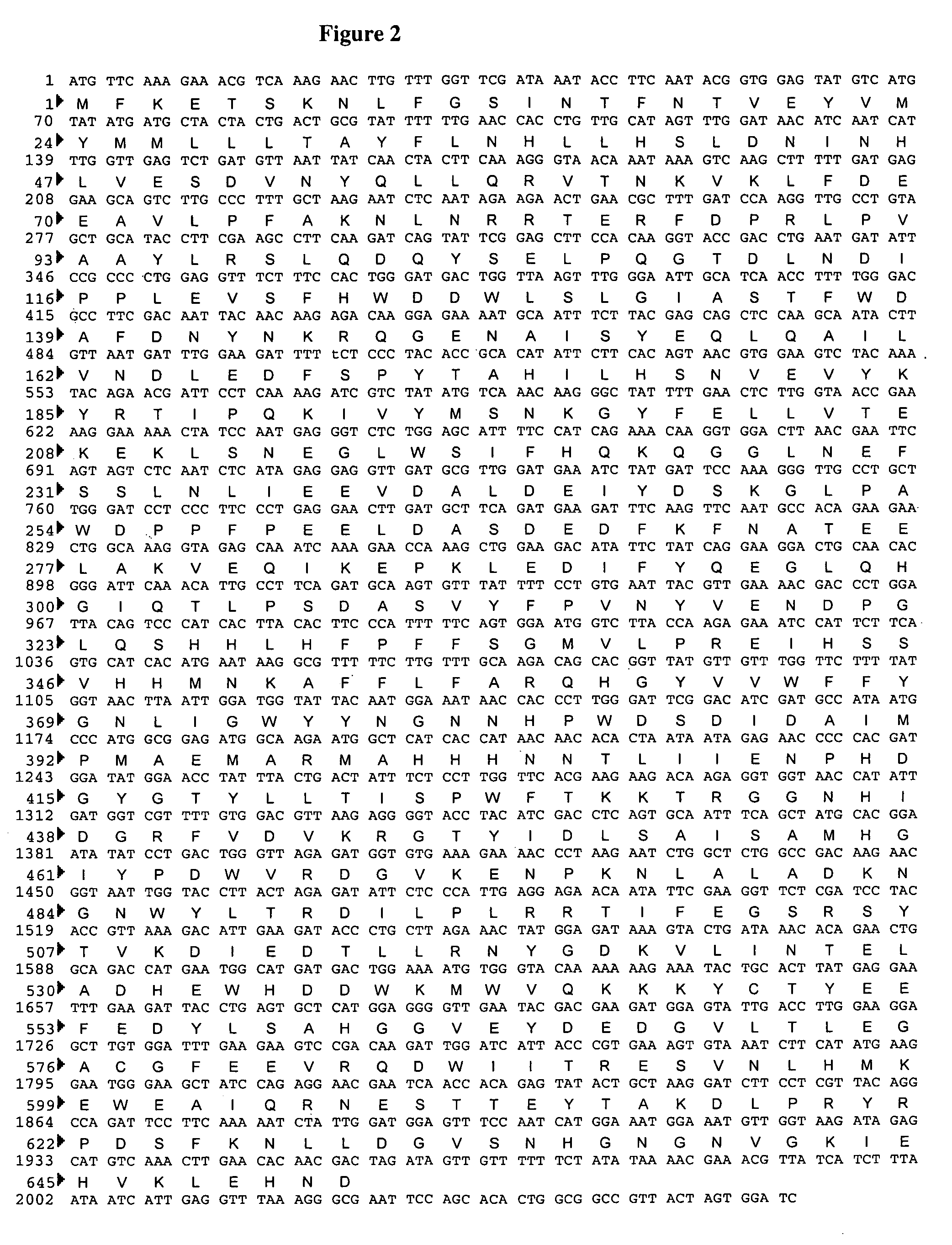Methods for eliminating mannosylphosphorylation of glycans in the production of glycoproteins
a technology of glycans and mannosylphosphorylation, which is applied in the direction of enzymology, peptides, transferases, etc., can solve the problems of long fermentation time, low protein titers, and heterogeneous products
- Summary
- Abstract
- Description
- Claims
- Application Information
AI Technical Summary
Benefits of technology
Problems solved by technology
Method used
Image
Examples
example 1
Identification and Sequencing of MNN4A, MNN4B, MNN4C in P. pastoris (FIGS. 1-3)
[0089]The Saccharomyces cerevisiae MNN4 protein sequence (Genbank accession #P36044) was blasted against a Pichia pastoris genomic sequence (Integrated Genomics, Chicago, Ill.) for open reading frames encoding for proteins with homology. This search identified three ORFs with regions of homology to MNN4p. These ORFs were designated MNN4A, MNN4B and MNN4C. Each of these three genes was subsequently sequenced. The MNN4A gene was found to contain an open reading frame containing 2580 nucleotide bases coding for 860 amino acids (FIG. 1). The MNN4B gene was found to contain an open reading frame containing 1956 nucleotide bases coding for 652 amino acids (FIG. 2), and the MNN4C gene was found to contain an open reading frame containing 2289 nucleotide bases coding for 763 amino acids (FIG. 3).
example 2
Construction of P. pastoris Strains: YSH-44 and YSH-1
[0090]P. pastoris YSH-44 and YSH-1 were engineered from BK64-1, an Δochl deletion mutant secreting K3, a reporter protein with a single N-linked glycosylation site (Choi et al., 2003, PNAS, 100: 5022-5027; Hamilton et al., 2003, Science, 301: 1244-1246). YSH-1 expresses glycoproteins having predominantly GlcNAcMan5GlcNAc2 N-glycans and YSH-44 expresses glycoproteins having predominantly GlcNAc2Man3GlcNAc2 N-glycans.
Deletion of PNO1 gene in YSH-44 Strain
[0091]The pno1 deletion allele (pno1::HygR) in YSH-44 was generated by the PCR overlap method (Davidson et al., 1999, Microbiol. 148: 2607-2615). Primers PNK1 (5′-CATAGCCCACTGCTAAGCC-AGAATTCTAATATG-3′) (SEQ ID NO:7) paired with PNK2 (5′-GCAGCGTACGAAGCTTCAGCTAGAATTGTAAAGTGAATTATCAAG-TCTTTC-3′) (SEQ ID NO:8), PNK3 (5′-CAGATCCACTAGTGGCCTATGCAACAA-TATAGCACCTCTCAAATACACGTTG-3′) (SEQ ID NO:9) paired with PNK4 (5′-TCTTGAAGTAGATTTGGAGA-TTTTGCGCTATG-3′) (SEQ ID NO:10) were used to amplify t...
example 3
PNO1 / MNN4B Knockout Strategy in P. Pastoris Strain YSH-49 (FIG. 4)
[0092]YAS-130 (Δpno1Δmnn4b) double mutant strain was achieved by PCR overlap in YSH-49. The TAS54 (TTCAACGAGTGACCAATGTAGA) (SEQ ID NO: 13) and TAS51 (CCAT-CCAGTGTCGAAAACGAGCTGGCGAACTTTTCTGGGTCGAAG) (SEQ ID NO:14) primers were used to amplify the 521 bp DNA fragment 5′ of the predicted start codon from Pichia pastoris genomic DNA (NRRL-Y 11430). TAS51 contains a 22 bp overhang that is complimentary to the 5′ end of a drug resistance marker. TAS49 (TGAAGACGTCCCCTTTGAACA) (SEQ ID NO:15) and TAS52 (ACGAGGCAAGCTAAACAGATCTAGTTGTTTTTTCTATATAAAAC) (SEQ ID NO:16) were used to amplify the 503 bp DNA fragment 3′ of the predicted stop codon. TAS52 also contains a 22 bp overhang that is complimentary to the 3′ end of the drug resistance marker. PCR of the drug resistance marker used pAG29 (contains pat ORF) as the DNA source (Goldstein and McCuster, 1999). The drug resistance marker was amplified using primers TAS53 (CTTCGACCCAGAA...
PUM
| Property | Measurement | Unit |
|---|---|---|
| Tm | aaaaa | aaaaa |
| temperatures | aaaaa | aaaaa |
| pH | aaaaa | aaaaa |
Abstract
Description
Claims
Application Information
 Login to View More
Login to View More - R&D
- Intellectual Property
- Life Sciences
- Materials
- Tech Scout
- Unparalleled Data Quality
- Higher Quality Content
- 60% Fewer Hallucinations
Browse by: Latest US Patents, China's latest patents, Technical Efficacy Thesaurus, Application Domain, Technology Topic, Popular Technical Reports.
© 2025 PatSnap. All rights reserved.Legal|Privacy policy|Modern Slavery Act Transparency Statement|Sitemap|About US| Contact US: help@patsnap.com



